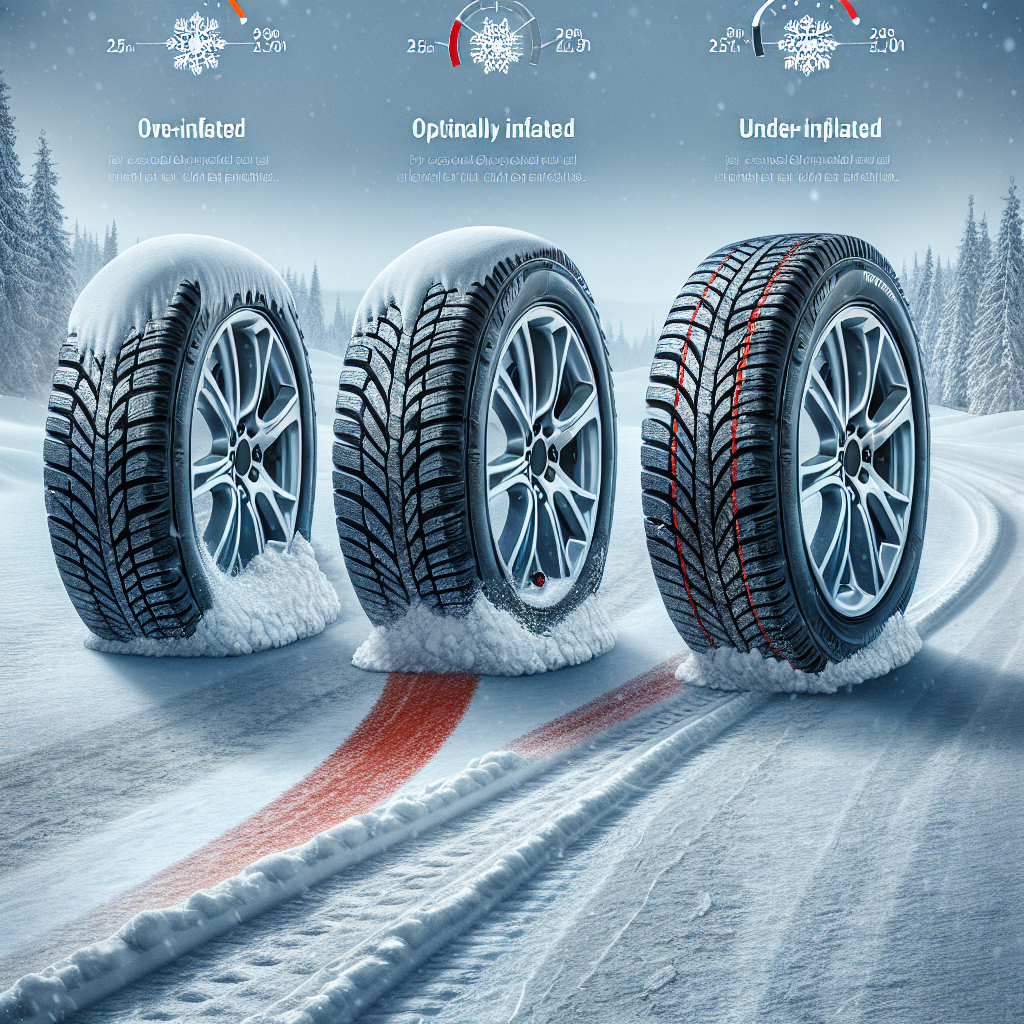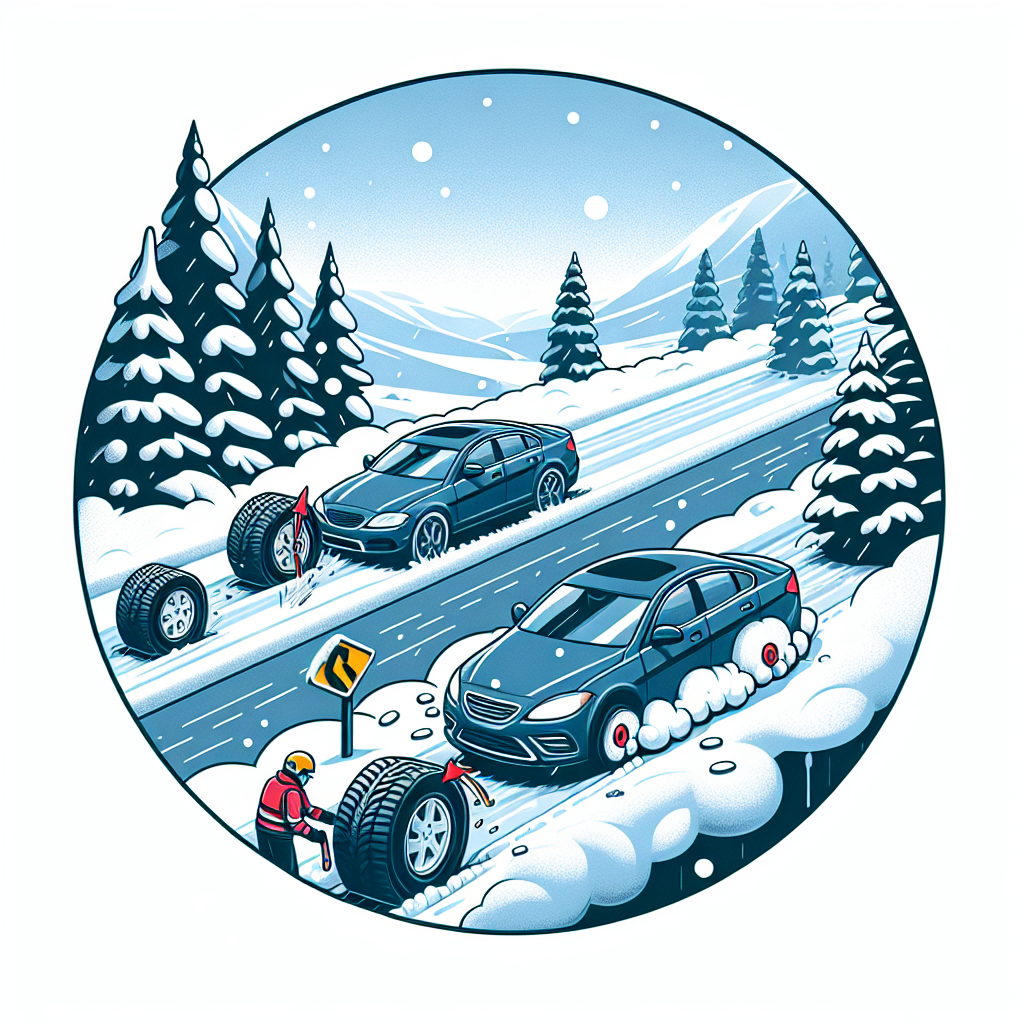In the pursuit of safe and efficient winter driving, understanding the role of tire pressure becomes crucial. Maintaining the appropriate tire pressure not only affects the overall performance of winter tires but also has a significant impact on traction, control, and braking. Whether you are embarking on a snowy adventure or simply commuting through the winter months, this article will shed light on the importance of tire pressure to enhance your winter tire performance. So, buckle up and let’s explore the fascinating relationship between tire pressure and winter driving.

Importance of Proper Tire Pressure
Maintaining Optimal Grip
One of the key factors that contribute to the performance of winter tires is their ability to maintain optimal grip on the road. Proper tire pressure plays a crucial role in ensuring that grip is maximized. When your tires are inflated to the recommended pressure, they maintain the ideal contact patch with the road surface. This contact patch allows the tire to effectively grip the road, providing you with the traction and control you need in winter conditions.
Enhancing Traction
Traction is essential when driving on slippery winter roads. Proper tire pressure helps enhance traction by ensuring that the tire’s tread interacts with the road surface in the most effective way. When the pressure is at the recommended level, the tread pattern is able to properly channel water, slush, and snow away from the tire, allowing it to maintain good contact with the road. This, in turn, improves your vehicle’s ability to accelerate, brake, and maneuver safely on winter surfaces.
Improving Handling and Stability
Winter driving requires precise handling and stability, especially when encountering challenging road conditions. Proper tire pressure plays a significant role in improving these aspects of your driving experience. When your tires are inflated to the correct pressure, they maintain their shape and stiffness, enabling them to respond quickly and predictably to your steering inputs. This leads to enhanced handling and stability, allowing you to navigate icy or snowy roads with confidence and control.
Effects of Cold Temperatures on Tire Pressure
Understanding Tire Pressure Loss
Cold temperatures have a direct impact on tire pressure. As the ambient temperature drops, the air molecules inside your tires lose energy, causing them to contract. This contraction leads to a decrease in tire pressure. It is estimated that for every 10-degree Fahrenheit drop in temperature, tire pressure can decrease by about 1-2 psi (pounds per square inch). This phenomenon of tire pressure loss in cold weather is important to understand, as it highlights the need for regular pressure checks and adjustments during the winter months.
Cold Weather and Tire Pressure
Cold weather can have a significant impact on tire pressure, and it is important to be aware of this as a driver. When the temperature drops, it is common for tire pressure to decrease. This decrease in pressure can affect the overall performance of your winter tires and compromise your safety on the road. Therefore, it is crucial to monitor and adjust tire pressure regularly during the winter season to ensure that your tires are properly inflated for optimal performance.
Recommended Tire Pressure for Winter Tires
Manufacturer’s Recommendations
To maximize the performance of your winter tires, it is essential to follow the manufacturer’s recommendations for tire pressure. These recommendations can usually be found in the vehicle owner’s manual or on a sticker located on the door jamb, glovebox, or fuel door. The manufacturer’s recommendations take into account factors such as tire size, vehicle weight, and driving conditions to determine the ideal tire pressure. It is important to adhere to these guidelines to ensure that your winter tires perform at their best.
Adjusting Pressure for Extreme Cold
In extreme cold temperatures, it may be necessary to adjust your tire pressure slightly to compensate for the pressure loss. Some tire manufacturers recommend increasing tire pressure by 1-2 psi during extremely cold weather conditions. This additional pressure helps offset the expected decrease in tire pressure due to the cold temperatures. However, it is important to note that this adjustment should be within the limits specified by the manufacturer and should not exceed the maximum tire pressure recommended for your specific tires.
Checking Tire Pressure Regularly
Regularly checking your tire pressure is crucial in maintaining optimal performance throughout the winter season. It is recommended to check your tire pressure at least once a month, and preferably once a week during the winter months. This regular monitoring allows you to identify any significant changes in tire pressure and make adjustments as needed. Additionally, this practice helps ensure that your tires are properly inflated, promoting even wear, enhanced traction, and improved fuel efficiency.
Underinflated Tires and Their Impact
Reduced Traction and Control
When your tires are underinflated, they have a larger contact patch with the road surface than intended. This increases the rolling resistance and compromises the tire’s ability to effectively grip the road. In winter conditions, underinflated tires can lead to reduced traction and control, making it difficult to accelerate, brake, and steer safely. Moreover, underinflated tires are more prone to hydroplaning on wet or slushy surfaces, further compromising your safety on the road.
Increased Wear and Tear
Underinflated tires experience increased wear and tear due to their improper contact with the road surface. The added stress on specific areas of the tire can result in uneven wear patterns, diminished tread depth, and reduced overall tire lifespan. In winter conditions, where road surfaces can be particularly abrasive due to snow, ice, and salt, underinflated tires are more susceptible to damage and premature wear. Regularly maintaining proper tire pressure helps prevent unnecessary wear and prolongs the life of your winter tires.
Decreased Fuel Efficiency
Underinflated tires lead to increased rolling resistance, which requires more energy to overcome. This increased resistance translates to decreased fuel efficiency, meaning that you’ll end up spending more money on gasoline or diesel. In winter driving conditions, where fuel consumption can already be affected by factors such as engine warm-up and increased use of accessories like defrosters, maintaining proper tire pressure becomes even more important to minimize fuel consumption and reduce associated costs.

Overinflated Tires and Their Impact
Reduced Grip and Traction
Overinflated tires have a smaller contact patch with the road surface than intended. This reduced contact area can compromise the tire’s ability to grip the road effectively, leading to reduced traction. In winter conditions, where road surfaces are often slippery, overinflated tires can make it more challenging to maintain control of your vehicle. The decreased grip can result in difficulty accelerating, braking, and cornering, potentially increasing the risk of accidents or skidding on icy surfaces.
Uneven Tire Wear
Overinflated tires can cause uneven wear patterns on the tread surface. The excessive pressure causes the center of the tread to bear more weight than the shoulders, leading to accelerated wear in the middle of the tire. This uneven wear not only compromises the tire’s performance but also reduces its overall lifespan. In winter conditions, where tire traction is crucial, it is important to maintain even tread wear to ensure optimal performance and safety on the road.
Potential Hazard on Icy Surfaces
When driving on icy surfaces, overinflated tires can pose a potential hazard. The reduced contact area between the tire and the road can limit the tire’s ability to gain traction on icy or snow-covered roads. This can result in decreased control and increased risk of sliding or spinning out of control. In extreme cases, the lack of grip from overinflated tires can make it nearly impossible to navigate safely on icy surfaces. Therefore, it is important to ensure that your winter tires are properly inflated to maximize grip and minimize the risk of accidents in winter conditions.
Adapting Tire Pressure for Different Winter Conditions
Snowy and Icy Roads
When driving on snowy and icy roads, it is important to adjust your tire pressure accordingly. Lowering the tire pressure slightly can increase the contact area between the tire and the road surface, improving traction and grip. This adjustment allows the tire to better bite into the snow or ice, providing you with enhanced control and maneuverability. However, it is important to note that this adjustment should be within the limits specified by the manufacturer and should not exceed the maximum tire pressure recommended for your specific tires.
Wet or Slushy Surfaces
Wet or slushy surfaces can be challenging to drive on, especially if your tires are not properly inflated. To optimize performance on such surfaces, it is recommended to maintain the recommended tire pressure as specified by the manufacturer. This helps ensure that the tire’s tread channels water and slush away from the contact patch, preventing hydroplaning and maintaining traction. Proper tire pressure on wet or slushy surfaces can significantly improve your vehicle’s handling and reduce the risk of accidents.
Dry and Cold Roads
On dry and cold roads, maintaining the recommended tire pressure is crucial to optimize performance. The proper inflation level ensures that the tire’s tread maintains optimal contact with the road surface, allowing for better handling and stability. In cold conditions, where tire pressure can be affected by temperature fluctuations, it is important to monitor and adjust the pressure regularly to ensure that it remains within the manufacturer’s recommended range. Properly inflated tires on dry and cold roads provide the necessary grip and control for a safe and enjoyable winter driving experience.

Additional Factors to Consider
Vehicle Load and Tire Pressure
It is essential to consider the weight of your vehicle and its cargo when determining the proper tire pressure. Heavier vehicles or those carrying a heavier load may require slightly higher tire pressure to account for the additional weight. Conversely, lighter vehicles or those carrying a lighter load may require slightly lower tire pressure. Consulting the vehicle’s owner manual or speaking with a tire professional can help you determine the appropriate tire pressure based on your specific vehicle and load requirements.
Alternating Winter and Summer Tires
Some drivers choose to alternate between winter and summer tires, depending on the season. When transitioning between tire types, it is important to adjust the tire pressure accordingly. Winter tires generally require slightly higher pressure compared to summer tires. Therefore, when switching to winter tires, it is necessary to increase the pressure to the level recommended by the tire manufacturer. Similarly, when switching back to summer tires, the pressure should be adjusted to the manufacturer’s recommendation for those tires. Proper pressure adjustment ensures optimal performance and safety throughout the year.
Consulting Tire Professionals
If in doubt about the proper tire pressure for your winter tires, or if you need assistance in determining the ideal pressure for your specific vehicle and driving conditions, it is always recommended to consult tire professionals. They have the expertise and knowledge to guide you in understanding the tire pressure requirements and can provide valuable recommendations based on your specific needs. Tire professionals can also assist in ensuring that your tires are correctly inflated and help address any concerns or issues related to tire pressure.
Proper Tire Pressure Maintenance
Using a Reliable Tire Gauge
Maintaining proper tire pressure starts with using a reliable tire gauge to accurately measure the pressure levels. A quality tire gauge allows you to get an accurate reading and ensure that your tires are inflated to the correct pressure. Digital or analog gauges are both suitable options, as long as they are properly calibrated and provide accurate readings. It is recommended to keep a tire gauge in your vehicle at all times, allowing you to check your tire pressure whenever needed.
Inflating or Deflating Tires
If you find that your tire pressure is too low or too high, it is important to take the necessary steps to adjust it. To inflate your tires, you can use an air compressor at a gas station or any other source of compressed air. When inflating, be sure to add air in small increments and check the pressure regularly to avoid overinflation. To deflate your tires, you can use a valve stem tool or press the pin on the valve stem to release air. Again, it is important to monitor the pressure as you deflate to avoid underinflation.
Monitoring and Adjusting Tire Pressure
Regularly monitoring and adjusting your tire pressure is crucial to maintaining proper inflation throughout the winter season. It is recommended to check your tire pressure at least once a month, and even more frequently during periods of extreme cold or significant temperature fluctuations. If you notice any significant changes in tire pressure, it is important to make the necessary adjustments to ensure optimal performance and safety. By making tire pressure checks and adjustments a routine part of your winter maintenance, you can enjoy the benefits that come with properly inflated tires.

Benefits of Maintaining Proper Tire Pressure
Improved Road Safety
One of the most significant benefits of maintaining proper tire pressure is improved road safety. When your tires are inflated to the correct pressure, they provide the necessary grip, traction, and control needed to navigate winter roads confidently. Properly inflated tires reduce the risk of accidents, skidding, and loss of control, allowing you to drive safely in challenging winter conditions.
Extended Tire Lifespan
Proper tire pressure not only enhances performance and safety but also extends the lifespan of your winter tires. When tires are inflated to the recommended pressure, they wear evenly and experience less strain during driving. This even wear pattern helps maximize the mileage you can get out of your tires, reducing the need for premature replacements. By maintaining proper tire pressure, you can prolong the lifespan of your winter tires and enjoy their benefits for longer.
Better Fuel Efficiency
Maintaining proper tire pressure can also contribute to improved fuel efficiency. When your tires are inflated to the correct level, they reduce rolling resistance, which translates to less energy needed to propel the vehicle forward. This decrease in rolling resistance results in better fuel economy, saving you money on fuel costs. With rising fuel prices, ensuring your tires are properly inflated is a simple and effective way to improve your vehicle’s fuel efficiency during the winter months.
Conclusion
Proper tire pressure is a crucial factor in maximizing the performance, safety, and longevity of your winter tires. Maintaining optimal grip, enhancing traction, and improving handling and stability are just some of the benefits associated with correct tire pressure. Understanding the effects of cold temperatures on tire pressure and regularly monitoring and adjusting the pressure are essential in ensuring your tires are properly inflated for winter driving. Whether it involves adjusting tire pressure for different winter conditions or consulting tire professionals for guidance, keeping your tires at the recommended pressure contributes significantly to improved road safety, extended tire lifespan, and better fuel efficiency. By prioritizing proper tire pressure maintenance, you can enhance your winter driving experience and face the challenges of winter roads with confidence and peace of mind.


